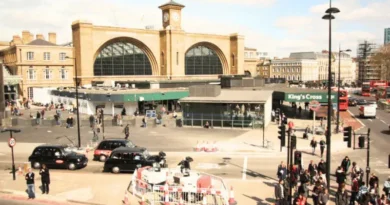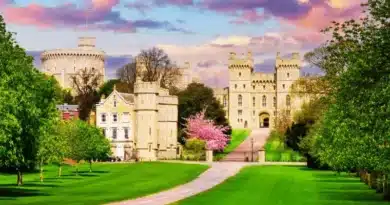What Days are Changing of the Guard at Windsor Castle
The Changing of the Guard ceremony at Windsor Castle is scheduled to take place on Tuesdays, Thursdays, and Saturdays at 11:00 am. Visitors can witness the guards marching from Victoria Barracks on Sheet Street, through Windsor High Street, and into the castle. An entrance ticket to Windsor Castle is required to view the actual changing ceremony. Please note that the schedule is subject to change and is weather-dependent; it’s advisable to check the official Household Division website for the most current information.
Takeaways
| Key Points |
|---|
| The Changing of the Guard at Windsor Castle is a prestigious and time-honoured ceremony that occurs at 11:00 am on Tuesdays, Thursdays, and Saturdays, with variations during special events such as Easter Court when the King is in residence. |
| The New Guard assembles at Victoria Barracks on Sheet Street, undergoes inspection, and marches towards Windsor Castle led by a Regimental Band, providing spectators with a musical and visual spectacle as they proceed through the town centre before entering via Henry VIII Gate. |
| Once inside the castle, the Old and New Guards participate in a formal handover outside the Guard Room in the Lower Ward, where the captains symbolically exchange keys, sentries are reassigned, and the Old Guard prepares for its return march to Victoria Barracks at approximately 11:25 am. |
| The ceremony, steeped in history since 1660, symbolises the seamless transition of security duties while showcasing the discipline of the Household Division, which includes regiments such as the Grenadier Guards, Coldstream Guards, and Irish Guards, with occasional participation from other military units, including the RAF and Commonwealth forces. |
| Visitors can enhance their experience by securing prime viewing spots along Windsor High Street for the procession or near St George’s Chapel within the castle, arriving early and being mindful of security protocols to fully appreciate this iconic display of British heritage. |
Introduction
The Changing of the Guard at Windsor Castle is a ceremonial tradition where The King’s Guard hands over responsibility for protecting the castle to a new guard. This event showcases British pageantry and has been a fixture of royal security since 1660. Visitors from around the world gather to witness the precision and grandeur of this historic ceremony.
Schedule of the Ceremony
- Regular Days and Times: The ceremony typically occurs at 11:00 am on Tuesdays, Thursdays, and Saturdays. There is no Changing the Guard on Sundays.
- Variations During Special Occasions or Royal Events: During Easter Court, when The King is in residence, the ceremony takes place on the lawn of the Quadrangle in the Upper Ward. In wet weather or winter, the ceremony occurs outside the guardroom by Henry VIII’s Gateway at the foot of Castle Hill to protect the lawn.
- Importance of Checking the Current Schedule Before Planning a Visit: The schedule is subject to change due to operational requirements or special events. It’s advisable to consult the official Household Division website for the most up-to-date information before planning your visit.
Procession Route
- Starting Point: Victoria Barracks on Sheet Street: The New Guard assembles and forms up at Victoria Barracks, located on Sheet Street, Windsor.
- March Through Windsor Town Centre: At approximately 10:45 am, the New Guard, led by a Regimental Band, departs from Victoria Barracks. They march along Sheet Street, proceed onto Windsor High Street, and continue towards Castle Hill. This procession offers spectators in the town centre an opportunity to witness the guards and band en route to the castle.
- Entry into Windsor Castle via Henry VIII Gate: Upon reaching the top of Castle Hill, the procession enters Windsor Castle through the Henry VIII Gate, leading into the Lower Ward, where the formal handover ceremony occurs.
- Return Route of the Old Guard: Following the ceremony’s completion, the Old Guard exits the castle, retracing the route back down Castle Hill, along the High Street, and returning to Victoria Barracks. This return march typically commences around 11:25 am, allowing spectators another chance to view the guards as they conclude their duties.
Witnessing the Changing of the Guard at Windsor Castle provides a unique glimpse into British ceremonial tradition, set against the backdrop of one of the nation’s most historic royal residences.
Detailed Ceremony Description
The Changing of the Guard at Windsor Castle is a time-honoured ceremony where the responsibility for guarding the castle is transferred from the Old Guard to the New Guard. This event is rich in tradition and showcases the discipline and precision of the British Army’s Household Division.
Formation of the New Guard at Victoria Barracks
The New Guard assembles at Victoria Barracks on Sheet Street in Windsor. Here, their officers inspect the soldiers to ensure they are impeccably turned out and prepared for their duty. The Regimental Band, which accompanies the New Guard, also forms up at the barracks, ready to lead the procession.
March to Windsor Castle Accompanied by a Regimental Band
At approximately 10:45 am, the New Guard, led by the Regimental Band, departs from Victoria Barracks. The procession moves along Sheet Street, turns onto Windsor High Street, and proceeds up Castle Hill. Spectators lining the route can enjoy the sight and sound of the marching soldiers and the band’s musical performance. The march culminates as the New Guard enters Windsor Castle through the Henry VIII Gate, arriving at the Lower Ward for the formal handover ceremony.
Handover Procedure Between the Old Guard and New Guard
Upon entering the castle, the New Guard forms up opposite the Old Guard outside the Guard Room in the Lower Ward. Both guards present arms, and the captains of the guards meet to symbolically hand over the keys to the castle, representing the transfer of responsibility. During this exchange, the Regimental Band accompaniment enhances the ceremonial atmosphere. Following the handover, the sentries of the Old Guard are relieved by members of the New Guard.
Posting of Sentries and Their Duties
After the formal handover, the New Guard posts sentries at various strategic points within the castle grounds. These sentries are responsible for maintaining security and are a visible symbol of the military’s role in protecting the royal residence. They stand vigil, remaining alert and attentive, and are periodically relieved throughout the day to ensure continuous protection.
Departure of the Old Guard Back to the Barracks
Once relieved of their duties, the Old Guard reassembles and prepares to march back to Victoria Barracks. Led by the Regimental Band, they exit the castle through the Henry VIII Gate, proceed down Castle Hill, along Windsor High Street, and return via Sheet Street. This departure march typically begins around 11:25 am, offering spectators another opportunity to witness the ceremonial procession.
The Changing of the Guard at Windsor Castle is a captivating display of British military tradition, reflecting centuries of history and the enduring relationship between the armed forces and the monarchy.
Purpose of the Ceremony
The Changing of the Guard at Windsor Castle is a ceremonial event that signifies the formal handover of duties between the Old Guard and the New Guard responsible for the castle’s security. This tradition not only serves a practical role in royal security but also embodies the rich heritage and continuity of the British monarchy.

Historical Origins of the Guard Change
The tradition of guarding the sovereign and royal residences dates back to 1660 when Household Troops were first assigned this duty. The formal ceremony of Changing the Guard has evolved over centuries, becoming a symbol of royal authority and the disciplined prowess of the British Army. This practice has been maintained at Windsor Castle to ensure the monarch’s protection and uphold ceremonial customs.
Role in Royal Security and Tradition
While the ceremony is a visual spectacle many appreciate, its primary function is the seamless transition of security responsibilities. The guards are not merely ceremonial; they are fully operational soldiers entrusted with the safety of the sovereign and the premises. The meticulous drills and procedures performed during the ceremony reflect the troops’ discipline and readiness, reinforcing the royal residence’s sanctity and security.
Symbolism and Significance in Modern Times
In contemporary society, the Changing of the Guard has transcended its original security purpose to become a symbol of the United Kingdom’s enduring traditions and historical continuity. It attracts visitors worldwide, offering them a tangible connection to British heritage. The ceremony exemplifies the blend of duty and pageantry, showcasing the nation’s respect for its monarchy and the ceremonial roles of its armed forces.

Participating Regiments
Overview of the Household Division
The Household Division is a prestigious segment of the British Army, comprising seven regiments that serve as the monarch’s personal troops. These regiments are renowned for their ceremonial duties and operational capabilities. They are primarily responsible for guarding royal residences, including Windsor Castle, and participating in state ceremonies.
Specific Regiments Involved
- Grenadier Guards: Established in 1656, the Grenadier Guards is the most senior regiment of Foot Guards. Recognizable by their distinctive bearskin hats and scarlet tunics, they have a storied history of valour in various military campaigns.
- Coldstream Guards: Formed in 1650, the Coldstream Guards is the oldest continuously serving regiment in the British Army. They are known for their motto, “Nulli Secundus” (Second to None), and have a rich tradition of both ceremonial and combat duties.
- Scots Guards: Originating in 1642, the Scots Guards have a deep-rooted connection to Scotland. They have served with distinction in numerous conflicts and are integral to state ceremonies and public duties.
- Irish Guards: Established in 1900 by order of Queen Victoria, the Irish Guards have a proud history symbolized by the shamrock adornment on St. Patrick’s Day. They are actively involved in ceremonial roles and operational deployments.
- Welsh Guards: The youngest of the Foot Guards, formed in 1915, the Welsh Guards have a strong association with Wales. They participate in ceremonial events and have been deployed in various military operations globally.
Occasional Participation of Other Units
While the Household Division primarily undertakes the Changing of the Guard, other units occasionally participate, adding diversity to the ceremony. For instance, the Royal Air Force Regiment assumes the guard approximately three weeks annually, with the King’s Colour Squadron often representing the RAF during these periods. Additionally, units from Commonwealth nations and other branches of the British Armed Forces, such as the Royal Navy and Royal Marines, have been invited to perform the guard change, reflecting the inclusive and collaborative spirit of the UK’s military traditions.
The participation of various regiments and units not only underscores the versatility and unity of the British Armed Forces but also enriches the ceremonial experience for spectators, offering a glimpse into the diverse components that contribute to the nation’s defence and heritage.
Musical Accompaniment

The Changing of the Guard at Windsor Castle is a visual spectacle and an auditory delight, largely due to the integral role played by the Regimental Band.
Role of the Regimental Band During the Procession and Ceremony
The Regimental Band leads the New Guard from Victoria Barracks to Windsor Castle, setting the ceremonial tone with their music. During the handover, the band performs a selection of pieces, enhancing the ceremony’s grandeur and providing a rhythmic backdrop to the precise movements of the guards. Their presence underscores the ceremony’s formal nature and adds a layer of pomp and circumstance that has become synonymous with British ceremonial traditions.
Types of Music Performed
The band’s repertoire is diverse, encompassing traditional military marches, classical compositions, and arrangements of contemporary popular music. This blend of genres not only honours longstanding military traditions but also engages a wide audience, reflecting the evolving nature of ceremonial music. The selection of music varies with each ceremony, ensuring a unique experience for spectators.
Notable Performances and Special Musical Units
Over the years, the ceremony has featured performances by various esteemed military bands, including the Band of the Coldstream Guards. Established in 1785, this band is renowned for its rich history and musical excellence. Special occasions may also see the inclusion of pipers or other unique musical elements, adding a distinctive flair to the event. These performances not only enhance the ceremony but also celebrate the musical heritage of the British Armed Forces.

Best Viewing Spots
To fully appreciate the Changing of the Guard, selecting an optimal viewing location is essential.
Locations Within Windsor Town for Observing the March
The guards march from Victoria Barracks on Sheet Street, proceeding up the High Street and into Windsor Castle. Prime viewing spots along this route include:
- Windsor High Street: Position yourself near the Guildhall or along the Corn Exchange for an unobstructed view of the procession.
- Sheet Street: This area offers a closer look at the guards as they commence their march.
Prime Areas Inside Windsor Castle for Viewing the Handover Ceremony
To witness the actual handover ceremony within the castle grounds:
- Lower Ward: The ceremony typically takes place outside the Guardroom in the Lower Ward. Arriving early can secure a spot near the railings below St George’s Chapel, providing an excellent vantage point.
- The Quadrangle: When the monarch is in official residence, the ceremony occurs on the Quadrangle’s lawn. Standing near St George’s Gate inside the castle allows for a close view as the guards and band march past.
Tips for Securing a Good Vantage Point
- Arrive Early: To ensure a prime spot, it’s advisable to arrive by 10:30 am, especially during peak tourist seasons.
- Be Mindful of Security: Expect airport-style security checks at the castle entrance. Allow sufficient time to pass through these procedures without missing any part of the ceremony.
- Consider Accessibility Needs: If you have mobility concerns, inform the castle staff upon arrival. They can guide you to suitable viewing areas that accommodate your needs.
Visitor Information
Proper planning enhances the experience of attending the Changing of the Guard.
Ticketing Requirements for Accessing Windsor Castle
While watching the guards march through Windsor town is free, witnessing the handover ceremony within the castle precincts requires a valid entrance ticket. Tickets can be purchased online in advance or at the castle’s ticket office on the day of your visit. Booking ahead is recommended to avoid potential queues and ensure availability.
Security Procedures and Entry Guidelines
Visitors should be prepared for thorough security screenings upon entering the castle. Prohibited items include large bags, sharp objects, and any items deemed a security risk. It’s advisable to carry minimal belongings to expedite the security process. Photography is permitted in certain areas; however, flash photography and tripods are typically prohibited.
Accessibility Considerations for Visitors with Disabilities
Windsor Castle strives to accommodate all visitors:
- Mobility Access: The castle offers step-free access to many areas, and wheelchairs are available for loan on a first-come, first-served basis.
- Assistance Dogs: Certified assistance dogs are welcome within the castle grounds.
- Visual and Hearing Impairments: Guides and information are available in various formats to assist visitors with visual or hearing impairments.
For specific needs, contacting the castle’s visitor services in advance is recommended to ensure appropriate arrangements.
Historical Evolution of the Ceremony
The Changing of the Guard has undergone significant transformations since its inception.
Origins of the Changing of the Guard
The tradition dates back to 1660, with Household Troops assigned to guard royal residences. The formalized ceremony evolved to signify the orderly transfer of guard duties, reflecting the disciplined structure of the British Army.
Major Changes and Developments Over the Centuries
Throughout its history, the ceremony has adapted to reflect contemporary practices while preserving its core traditions. Adjustments have included changes in uniform design, the inclusion of diverse musical repertoires, and the participation of various regiments, each bringing unique elements to the ceremony.
Notable Events and Milestones Associated with the Ceremony
The ceremony has marked significant national events, such as coronations, jubilees, and state visits. Notably, in 2001, following the September 11 attacks, the Band of the Coldstream Guards performed the U.S. national anthem during the Changing of the Guard at Buckingham Palace, showcasing solidarity and the ceremony’s capacity to honour global moments.
FAQ
On which days does the Changing of the Guard at Windsor Castle occur?
The Changing of the Guard ceremony at Windsor Castle typically takes place on Tuesdays, Thursdays, and Saturdays at 11:00 am. However, the schedule is subject to change, so it’s advisable to check the official Household Division website for the most up-to-date information.
What time does the Changing of the Guard ceremony start?
The ceremony begins at 11:00 am inside Windsor Castle. Prior to this, at approximately 10:45 am, the new guard departs from Victoria Barracks and marches through Windsor town centre to the castle.
Where is the best place to watch the guards march?
To observe the guards marching to the castle, position yourself on Windsor High Street or under the Corn Exchange at Windsor Guildhall. These locations offer excellent views of the procession as it moves from Victoria Barracks to the castle.
Do I need a ticket to see the Changing of the Guard?
Watching the guards march through the town is free and doesn’t require a ticket. However, to view the actual Changing of the Guard ceremony inside Windsor Castle, you’ll need to purchase an entrance ticket to the castle.
How long does the Changing of the Guard ceremony last?
The ceremony inside the castle lasts approximately 30 minutes. The entire event, including the march to and from the castle, spans about 45 minutes.
Is the Changing of the Guard ceremony held daily?
No, the ceremony is not held daily. It typically occurs on Tuesdays, Thursdays, and Saturdays, but the schedule can change. Verifying the dates on the official Household Division website before planning your visit is recommended.
What happens if it rains during the ceremony?
The ceremony is weather-dependent. In light rain, the guards may march without musical accompaniment. In cases of heavy rain or adverse weather conditions, the ceremony may be cancelled. It’s advisable to check for updates on the day of your visit.
Can I take photographs during the ceremony?
Photography is permitted outside the castle buildings, including during the guards’ march and the ceremony in the Lower Ward. However, photography is strictly prohibited inside the State Apartments and St George’s Chapel.
Are there any security measures I should be aware of?
Yes, security personnel are present during the ceremony to ensure public safety. Visitors are advised to take care of personal belongings, as crowded areas can attract pickpockets. Report any suspicious behaviour to a police officer.
Is there seating available for spectators?
There is no designated seating for spectators during the outdoor march or the ceremony inside the castle. It’s recommended to arrive early to secure a good viewing spot, especially during peak tourist seasons.
Can I watch the ceremony without entering Windsor Castle?
You can watch the guards march through the town without entering the castle. However, an entrance ticket is required to witness the Changing of the Guard ceremony, which takes place inside the castle grounds.
Are there any days when the ceremony doesn’t take place?
The ceremony does not occur on Sundays. Additionally, it may be cancelled on certain days due to special events or operational requirements. Always check the official schedule before your visit.
What is the route of the guards’ march?
The guards march from Victoria Barracks on Sheet Street, proceed up the High Street, and enter Windsor Castle through the Henry VIII Gate. This route offers several vantage points for spectators along the way.
Is the ceremony suitable for children?
Yes, the ceremony is family-friendly and can be an enjoyable experience for children. The colourful uniforms, marching band, and pageantry often captivate younger audiences.
Are there any accessibility provisions for disabled visitors?
Windsor Castle offers accessibility accommodations, including concessionary rates for individuals with disabilities and complimentary admission for accompanying companions. However, the outdoor nature of the ceremony means seating is not provided, so plan accordingly.
Can I bring pets to the ceremony?
Pets are not permitted inside Windsor Castle grounds. While you can have pets in the town area, it’s advisable to consider the crowded environment during the guards’ march, which may not be suitable for animals.
Is there parking available near Windsor Castle?
Windsor Town offers several pay-and-display car parks within walking distance of the castle, such as River Street Car Park (SL4 1QT) and Alma Road Car Park (SL4 3HY). A park-and-ride service is also available at Romney Lock (SL4 6HX).









